Ladders are serious structures that require careful calculations in accordance with existing rules and regulations. Since the stairs sometimes take us to a rather large height, they should be as safe as possible.
And, proceeding from the fact that the movement when climbing along them makes us spend twice as much energy as moving horizontally, certain requirements are also imposed on the comfort of the stairs.
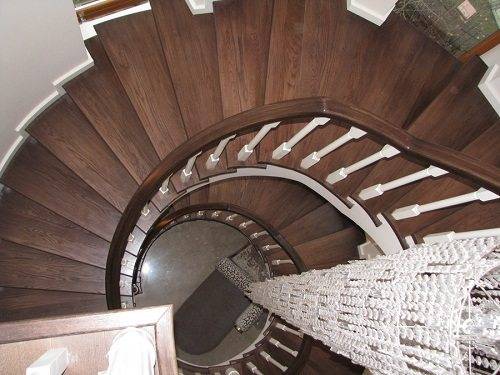
Finished products - expensive products
Standard flights of stairs, steps and platforms of mass production are produced in accordance with GOSTs for the corresponding structures. Customized products are designed and calculated by appropriately qualified professionals.
Of course, you don't need to be a genius to understand that the price of their services is inflated several times, depending on the fame of the organization and the complexity of the chosen project. Of course, if you have extra money, then why not use this service, but in the case of a modest budget, any "penny" is tangible.
That is why we will talk about how to calculate steps for a staircase that is being built by our own hands - in order to save on high-quality materials and decorative finishes.
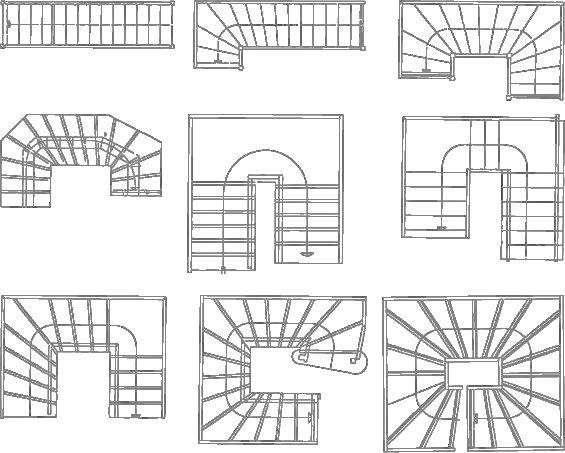
Stair options
Before calculating the steps of the stairs, let's figure out the definitions with which we will have to operate:
- Step depth (tread).
- Step height (riser) - the distance between the steps of the stairs. This element is not obligatory for our design, it often plays a decorative role, rather than affects the strength of the stairs.
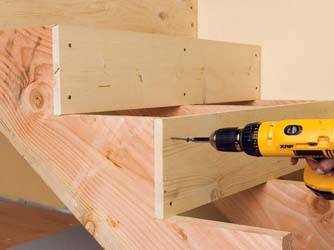
- Tread width.
- Thickness - occurs when overhead products are placed on a base made of a different material.
- The number of steps in the march.
Calculation of the linear dimensions of the steps
Tread and riser
There is a formula for calculating the steps of a staircase for a comfortable walk along it. In practice, it has been determined that the safety and convenience of a ladder ensures the equality of the sum of twice the height of the riser and the depth of the tread with the average step of a person. The stride length of a person moving horizontally averages 600-650 mm.
We get the formula 2A + B = 600-650 mm. You can also use a simpler, easy-to-remember formula A + B = 450 mm +/- for circumstances 20 mm, where A is the distance between the steps of the stairs, B is the depth of the tread.
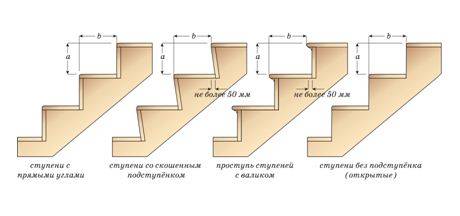
Obviously, a comfortable tread depth should correspond to the length of the person's foot, to ensure that the leg is supported by the whole foot, that is, in the range between 200 and 320 mm. These are average values. When calculating your ladder, take into account the physiological characteristics and wishes of your family - the main users of this design.
But do not deviate much from the optimal parameters (riser from 150 mm, tread 300 mm). The main reference point for calculations is children.
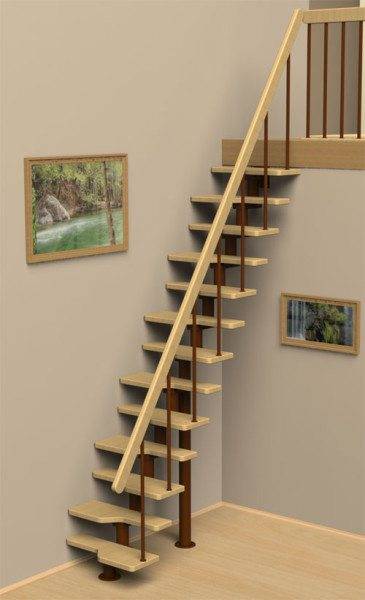
Advice!
Owners of large feet, nevertheless, should not increase the depth of the tread too much, since, moving along such a ladder, it is easy to lose a step.
And when the steps are narrowed, the descent becomes difficult.
If, for some reason, it is impossible to arrange a sufficiently deep tread, it is performed with an overhang over the lower surface, the overhang should not exceed:
- For wood products 30 mm.
- For reinforced concrete 50 mm.
Another trick to increase comfort when navigating a structure with shallow steps is to remove risers from the structure. This will provide extra legroom, as we said earlier.
Equally, the height of the riser has an effect on the convenience of moving up and down. Climbing too high treads, you will quickly get tired, and the descent will bring real discomfort, on low ones - you risk getting lost and entangled in your own legs with frequent steps.
All of the above applies to ordinary steps. When designing a staircase with run-in steps, it should be taken into account that the depth of the narrowest part of the tread should not be less than 100 mm, and its overhang over the previous surface should not exceed 50 mm.
For an accurate calculation of winder products, you will have to work more. Everything should be drawn on paper, since each tread will have an individual configuration and size.
Winder steps
Below is an instruction for drawing the winders of a two-flight staircase with a turn of 90 degrees:
- First of all, draw a circle with a radius equal to ½ of the tread width (for such structures, at least 90 cm is optimal).
- Let's draw the middle line of our marches through the center of the circle at an angle of 45 degrees.
- Divide the circle into segments according to the size of the steps of the ordinary steps.
- Now we apply two straight sections of flights of stairs along the middle line.
- Draw lines AC and AB along the inner edge of the steps, retreating approximately by the width of the supports known to us. From point A we will draw vectors for calculating the winders.
- Lines AB and AC must be positioned so that the narrow part of the winder steps looms at least 10 cm, and the far, wide one within 40 cm.
- By moving the lines AC and AB to draw tread patterns, the width at the edges of the products can be slightly changed, leaving the tread depth unchanged in the center.
Following this scheme, you can calculate the staircases of various configurations.
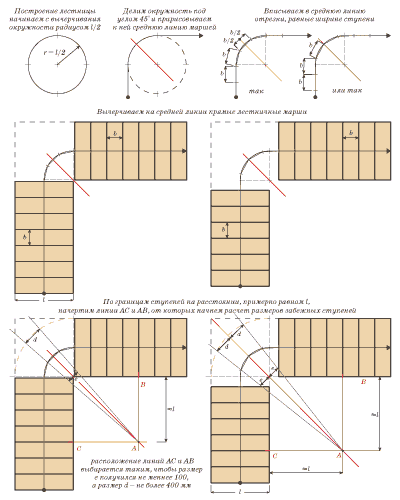
For your information!
Before the run-in fragment at the foot of the stairs, it is advisable to arrange an ordinary step (podium), you can even more than one.
This will make the climb smoother and less hazardous.
Width of steps
The width of the tread (the distance from one edge to the other) is worth talking about separately. This value varies depending on the type of ladder, its location and purpose.
Considering all the conditions, several types are distinguished:
- Standard width (900-1000 mm). This is a variant of an ordinary structure for the simultaneous movement of one person on it, moving large-sized objects, for example, furniture.
- Extended (1100-1250 mm). All of the above manipulations on it, of course, are performed with great convenience and comfort.
- Wide (1500 mm). Two people freely move along such a staircase (possibly in different directions), and even a piano can be lifted along it without any problems.
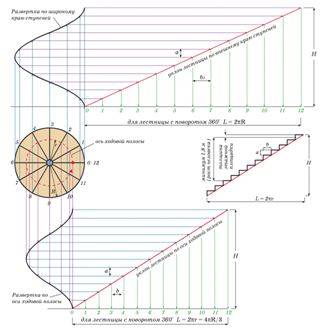
Number of steps
Before calculating the number of stair steps, we will collect the necessary primary data:
- Staircase design decision.
- Floor height, that is, the difference in the floor marks of the first and second floors (taking into account the thickness of the covering layer-screed and floor covering)
- The planned angle of inclination of the structure.
- Step height.
Important!
The angle of inclination for a comfortable and ladder is in the range of 30-45 degrees in relation to the floor. A slope that exceeds the upper limit makes climbing stairs very difficult.
Above 50 degrees will force you to descend only with your back forward.
A slope of less than 25 degrees makes the device of such contraction impractical, in such a case, you can get by with a flat ramp.
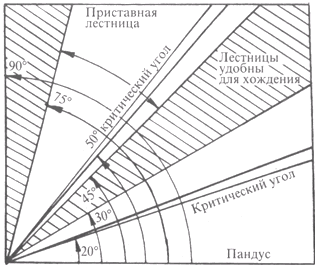
Now let's perform a simple calculation of the number of stair steps:
- We divide the height of the floor by the height of one tread and get the required number of steps in the march.
- Through the angle of inclination and the height of the floor, we find the approximate length of the march.
- By dividing the length of the march by the number of steps, we determine the depth of the tread.
Advice!
When calculating, you may end up with a non-symmetrical distribution, but the location of the tread should be with an equal tread depth.
This problem can be solved by slightly adjusting the length of the stairs, changing the angle of inclination.
If this is not possible, leave the step at the foot of the march larger in relation to the rest.
As you can see, there is nothing particularly difficult in how to calculate the rungs for the stairs. As for screw products, everything is a little more complicated here, but we gave a calculation scheme in the article, if you follow it and the information that you read above, you can build a more complex structure.
Output
Agree, even if you spend 1-2 days on these calculations, the savings are in any case on your side, just imagine that for a finished project they usually ask for several thousand rubles. Of course, only the sequence and correctness of all actions will lead to a positive result, but since the structure is being built on your own, then you have the opportunity to adjust the dimensions.
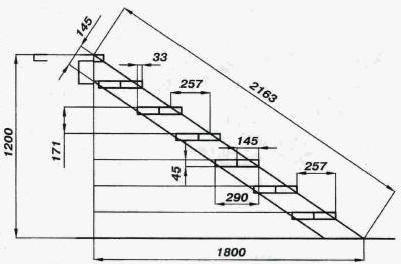
In the video presented in this article, you will find additional information on this topic.






